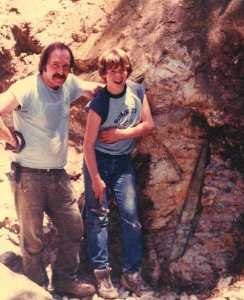Map of the Bennett Mine from the 1968 Bureau of
Mines Report 7070
'New England Beryllium Investigations'
Map of the Bennett Mine from the 1968 Bureau of
Mines Report 7070
'New England Beryllium Investigations'
the following is an excerpt from the Bureau of Mines report page 90-91:
“The pegmatites exposed in the various pits appear to be true dikes 15 to 70 feet wide, standing nearly vertical and ranging in strike from several degress north of due east to a few degrees south of due east. Two unexplored pegmatite outcrops on the property strike almost north-south and are cut by milky quartz veins that strike and dip in accord with the development of the pegmatites. The relationship of the various pegamatites with one another is obscure. The examined pegamtites are zoned with the following general sequence in from the wall rock: Plagioclase-quartz-perthite with accessory black tourmaline, apatite, muscovite, and beryl; quartz-perthite with accessory black tourmaline, plagioclase, apatite and beryl; irregular pods and veins of milky quartz with accessory beryl. There are sporadic cleavelandite replacement bodies containing many associated rare minerals such as lepidolite, spodumene, pollucite, herderite, and colored tourmaline along with the ubiquitous beryl. One of these cleavelandite-rare mineral replacement bodies can be seen in the western wall of pit 1. A quartz pod which has been exceptionally rich in green and blue beryl is exposed at the base of the east face in pit 3.”
The report went on to conclude that commericial beryllium production from these pegmatites was not promising.
In this report the Orchard Quarry is labeled
as Pit#3. The world famous Bennett Mine is Pit#1. The Bennett Mine was
first opened in the 1920' s
for the recovery of feldspar. It was operated by Paul Bennett and a host
of others including Loren Merrill and Dick Nevell, Stanley Perham,
the Maine Feldspar Company and others. Perhaps the highlight of the Bennett's
gem history was the discovery of the 'Rose of Maine', an enormous Morganite
beryl, by Dennis and Ron Holden. Other notable specimens have been huge
quartz crystals, gem green tourmalines, herderites, rhodocrosites, gem
grade pollucite, and magnificent cassiterites. The Bennett pegmatite has
been well studied and documented and is considered to be prototypical of
Oxford County Maine pegmatites.
s
for the recovery of feldspar. It was operated by Paul Bennett and a host
of others including Loren Merrill and Dick Nevell, Stanley Perham,
the Maine Feldspar Company and others. Perhaps the highlight of the Bennett's
gem history was the discovery of the 'Rose of Maine', an enormous Morganite
beryl, by Dennis and Ron Holden. Other notable specimens have been huge
quartz crystals, gem green tourmalines, herderites, rhodocrosites, gem
grade pollucite, and magnificent cassiterites. The Bennett pegmatite has
been well studied and documented and is considered to be prototypical of
Oxford County Maine pegmatites.
The history of the Orchard Pit (Quarry) is neither so well documented nor has its output been as bountiful. What is remarkable about the Orchard Pit is its abundant beryl. When this small pit was first opened is not known. It has been worked by Frank Perham in 1962, Ron Larrivee and Charlie Bragg, Ernie Schlicter and his partner Bob Eastman, Dennis Holden, Mike Jacobs and others. Unfortunately no lithium enrichement has been noted. In the photo, Paul Nash and his son proudly pose beside a large beryl. This view from about 1980 is of the nothern wall at the western end of the pit . Their beryl is probably is as large as any that have been found at the Orchard. No beryls even approaching this size have been found during current operations.